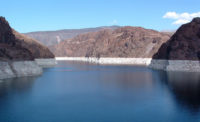Environment
NW Drought Prompts New Corps Water Management on Lake Washington

A tugboat navigates the Hiram M. Chittenden Locks on Seattle's Lake Washington. The US Army Corps of Engineers have enacted restrictions on lock navigation due to lower than normal lake water levels.
Photo courtesy US Army Corps of Engineers
As drought concerns grow across the dry Pacific Northwest, the U.S. Army Corps of Engineers is taking steps to conserve water at Seattle’s Lake Washington to keep the lake at or above an elevation of 20 ft.
Current projections have the lake dropping below 20 ft by the end of September. The Corps aims to maintain the water level between 20 and 22 ft throughout the year to ensure fish passage, navigation and salinity controls.
The agency typically targets a 22-ft elevation by late May to early June and water consumption throughout the summer draws the level down. The early dry spring generated new challenges for water management at the Hiram M. Chittenden Locks, the Corps says.
In June, the Washington Dept. of Ecology declared a drought in 12 counties across the state. Jeff Marti, drought coordinator for the state Water Resources Program, says that statewide, May and June were the fourth warmest since 1895 and 11th driest. Marti expects May through July figures to be “in the same ballpark.”
On Lake Washington, the effort to conserve water includes increasing the number of vessels in each locking to reduce daily consumption and prioritizing use of small locks. These measures will help reduce risk for added interventions later in the summer, but the Corps warns those with floating structures on Lakes Washington and Union or the Lake Washington Ship Canal to prepare for possible lower water levels.
A spokesperson for the Corps Seattle district says “if conditions worsen there is the possibility for additional changes to amount and/or timing of lockages and consideration of allocation to environmental benefits.”
The record low Lake Washington level is 18.35 ft, reached in 1958. The last time it dropped below 20 ft was the 19.91 ft measured in August 2015.
Oregon added Jackson County to the list of nine counties with a drought declaration in 2023. The central part of the state has fared the worst.
A spokesperson for the Corps Portland district says that systemwide storage in the Willamette Valley is lower than normal due to May being unseasonably dry and warm.
“The last few years have been a hydrologic roller coaster,” said Salina Hart, district reservoir regulation chief, in a statement, “and this year is no exception.”



